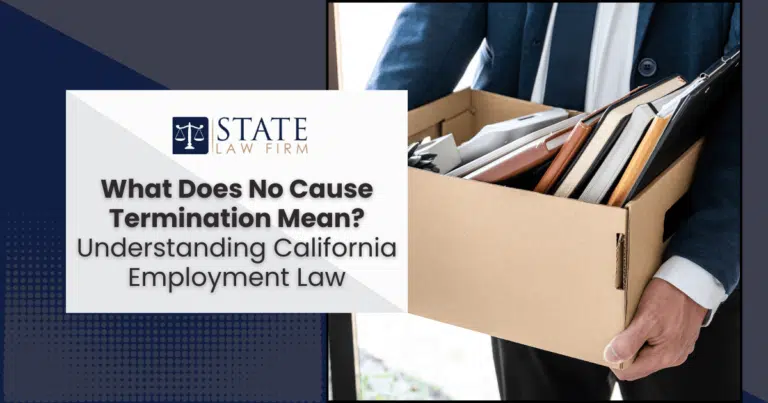In the ever-evolving landscape of California employment law, understanding the concept of “no cause termination” is crucial for both employees and employers. California’s status as an at-will employment state means that, in most cases, employers can terminate employees without providing a specific reason—yet this doesn’t mean such terminations are without legal boundaries. In fact, wrongful termination lawsuits accounted for over 50% of employment-related claims filed in the U.S. in recent years (source). This highlights the importance of clarity and compliance when navigating no-cause termination policies.
At State Law Firm, we’re dedicated to empowering individuals with knowledge while advocating for their rights. Our boutique personal injury law firm, based in Sherman Oaks, takes pride in helping clients face complex legal challenges and pursue justice. If you’re exploring employment law issues or dealing with workplace disputes, our team is here to support you. Learn more about our approach to legal advocacy on our premises liability page.
This guide will provide an overview of no-cause termination in California, including its legal framework, implications for employees, and best practices for employers. Whether you’re navigating this as an employee or employer, understanding these key aspects can help you make informed decisions in the workplace.
Introduction to No Cause Termination in California
California is one of the few states in the U.S. that operates under an at-will employment framework, allowing employers to terminate employees without providing a specific reason. This is commonly referred to as no-cause termination. While at-will employment offers flexibility, it also raises questions about employee rights and employer obligations.
For employees, understanding the nuances of at-will employment is vital to navigating workplace challenges and ensuring fair treatment. Employers, on the other hand, must tread carefully to avoid potential legal claims stemming from wrongful termination.
If you’re questioning whether your dismissal was lawful or are uncertain about your rights under California labor laws, read more about Can I Be Fired For No Reason in California to clarify common misconceptions.
The Legal Framework of At-Will Employment in California
The at-will doctrine is the cornerstone of California’s employment law, granting employers the ability to terminate employees at their discretion—provided the termination does not violate federal or state law.
Key Points for Employees:
- Employers cannot terminate employees for reasons that are discriminatory, retaliatory, or otherwise unlawful.
- Protected categories include race, gender, religion, age, disability, and other characteristics under state and federal anti-discrimination laws.
Key Points for Employers:
- Clear, written termination policies can minimize legal risks.
- Employers should maintain consistent documentation for all employment actions, especially when dismissing employees.
Pro Tip: Employers can avoid costly litigation by ensuring that managers and HR teams are trained on termination policies and compliance requirements.
When Can an Employer Use No Cause Termination?
While at-will employment allows employers to terminate employees without cause, it does not grant carte blanche. Terminations must remain within legal boundaries, such as:
- Performance Issues: Employers can lawfully terminate employees for subpar performance without a formal warning under at-will rules.
- Organizational Changes: Layoffs due to restructuring or budget cuts are generally lawful.
- Legal Considerations: Terminations must not be based on discriminatory practices, retaliation, or violations of employment agreements.
When Employers Must Be Cautious:
- Firing employees soon after they file complaints about workplace conditions.
- Dismissing an employee who has exercised legal rights, such as taking medical leave.
The Implications of No Cause Termination for Employees
For employees, losing a job without cause can feel abrupt and unfair. However, there are safeguards in place to protect workers in certain situations.
Employee Protections to Be Aware Of:
- Unemployment Benefits: Employees dismissed without misconduct are typically eligible for unemployment benefits.
- Severance Pay: While not mandatory in California, some employers offer severance packages, especially in layoffs.
- Legal Recourse: If termination violates anti-discrimination laws or public policy, employees may have grounds to file a lawsuit.
Pro Tip: Document all interactions with your employer leading up to your termination. This information can be invaluable if you decide to pursue legal action.
Differences Between No Cause and Just Cause Termination
Unlike no-cause termination, just-cause termination requires a valid reason related to an employee’s performance or behavior.
Just Cause Termination Examples:
- Repeated violations of company policy.
- Poor performance despite multiple warnings.
- Acts of misconduct, such as theft or harassment.
No Cause Termination vs. Just Cause:
- No Cause: Offers flexibility for employers but limited explanation for employees.
- Just Cause: Requires employers to provide clear, documented reasons for dismissal.
Pro Tip for Employers: Maintaining detailed records of employee performance and disciplinary actions can support a defense in case of a wrongful termination claim.
Best Practices for Employers Regarding No Cause Termination Policies
To minimize the risk of litigation and promote fairness, employers should adopt the following best practices:
- Communicate Policies Clearly: Ensure all employees understand at-will employment policies through onboarding and employee handbooks.
- Conduct Terminations with Care: When dismissing employees, focus on professionalism and respect.
- Document Everything: Keep detailed records of employment decisions, including performance reviews and disciplinary actions.
- Train Managers: Provide training on legal compliance to reduce risks of discriminatory or retaliatory terminations.
Pro Tip: Regularly review termination policies with legal counsel to stay updated on California labor law changes.
Conclusion
Navigating the complexities of no-cause termination in California requires a clear understanding of the at-will doctrine and the legal protections available to employees. Whether you’re an employee wondering if your dismissal was lawful or an employer aiming to avoid wrongful termination claims, staying informed is essential.
At State Law Firm, we’re here to guide you through these challenges with personalized legal strategies and dedicated advocacy. For more insights into employment law and related legal matters, explore our premises liability page or contact our team to discuss your case.


